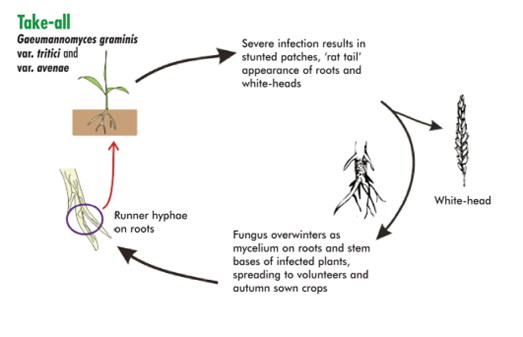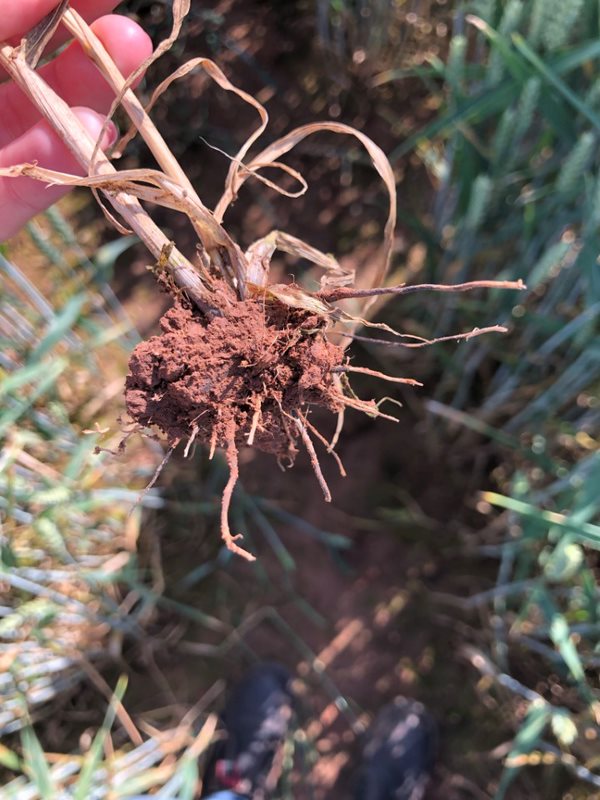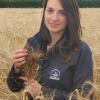Damage and Economic Importance
Take-all is one of the most important diseases of wheat in the UK. This is because unlike many other cereal diseases, it is not easily controlled chemically or by varietal resistance and relies mainly on rotational strategies and other methods for control. The disease develops in short rotations where wheat or other susceptible cereal species are grown consecutively for two or more years in the same field. In the first wheat crop in a rotation, take-all fungal inoculum builds-up in the soil root-zone (rhizosphere) but there is generally very little root infection and minimal risk to the crop’s performance. However, if a second wheat crop is then sown on the same site there is a risk of severe take-all disease developing.
Second wheat crops in the rotation will typically yield around 10-15% less than a first wheat crop, primarily due to take-all and in notable outbreak years, where weather conditions are particularly conducive to take-all development, yield losses of up to 60% have been reported and grain quality also greatly reduced.
Take-all causes most damage in light soils, particularly if they are alkaline and the crop is early sown. Early sowing gives more time for the fungal inoculum to build up in the soil and subsequently come into contact with and infect the root. Severe attacks can also occur in acidic patches and poor drainage and nutrient status also encourages disease.
The disease is usually most severe in second, third and fourth wheat crops but generally declines in importance in continuous cereals. This is known as take-all decline. This natural decline in take-all disease and yield improvement usually occurs from the 4th or 5th wheat crop onwards due to natural build-up of useful antagonists. Unfortunately, a severe take-all outbreak during the second to fourth wheat crops is required to trigger the onset of take-all decline.
Appearance and lifecycle

The take-all fungus survives the winter as mycelium primarily on root or stubble debris but also on volunteer cereals, early autumn-sown crops, and some grass weeds. Primary infection occurs in autumn from inoculum in the soil and secondary infection (root-to-root) occurs mostly in spring and summer. The disease spreads from infected seedling roots to developing crown roots.
The fungus attacks the roots of the plant causing the roots to have a blacked, rotten “rat-tail” appearance. As the disease progresses, the root area lost increases and the ability of the plant to absorb water and nutrients declines. When root rotting is severe plants are unable to absorb water and nutrients resulting in premature ripening causing white-heads visible in the crop and poor grain filling, sometimes without any grain at all.
Management Recommendations
Varietal resistance and fungicides:
Currently there are no resistant varieties against take-all available in AHDB Recommended List (RL). However, first and second wheat yield performance are provided on the RL and can give indications as to those varieties which yield best as a second wheat in the rotation. In addition, although all varieties are susceptible to take-all, some are more tolerant to take-all risk than others.
No foliar applied fungicides can control take-all however, seed treatment fungicides such as silthiofam (commercially available as Latitude) can provide partial control against the disease however, should be combined with other control strategies.
Field husbandry:
Management of crop rotation by using non-cereal, broad-leaved break crops or oats (provided that the oat attacking strain of the take-all fungus is not present) will control take-all disease in a following 1st cereal crop by reducing the amount of inoculum that builds up.
Ensuring there is good control of cereal volunteers and grass weeds (particularly couch grass and bromes) prior to cereal drilling will also decrease levels of take-all inoculum present in the soil.
After harvest of the first wheat crop take-all inoculum begins to decrease in the soil relatively rapidly and therefore, delaying drilling with a longer inter-crop period and sowing later (preferably mid-October or later) can therefore help to reduce disease severity in second and subsequent wheat crops. It is also important that cereal volunteers are well controlled during this inter-crop period as any benefit of delayed drilling will be lost.
Decreasing seed rate can help reduce take-all infection due to decreased root density and can help increase yield when take-all is severe. However, this may not be practical if crops are later sown.
Nutrient management:
Efficient and correct nutrient management can help to decrease take-all risk. Maintaining phosphate and potassium above index 2 can help to reduce disease severity and ideally any nutrient deficiencies should be corrected before the break crop and sequence of wheat crops are sown. Other nutrient deficiencies such as manganese, potash and sulphur have been linked to increased take-all severity so ensuring these are at optimum levels prior to sowing can help eliminate risk.
In crops at risk of take-all disease (non-first wheats) a split nitrogen application with an early application in February or March before the main application in April can help reduce the impact of take-all. This is because take-all destroys the roots reducing the crop’s ability to take up nitrogen and other nutrients. If nitrogen is applied before the pathogen takes hold of the root, the crop will be able to use this nitrogen in essential plant processes such as chlorophyll production for photosynthesis thus, increasing final yield.
Related Links
AHDB Encyclopedia of Cereal Diseases
Some of the text on this page comes from Rothamsted's Croprotect web platform at https://croprotect.com/diseases/take-all-root-disease
This page is also supported by funding from The British Society for Plant Pathology (BSPP).







